Growing leeks in open ground and caring for them from planting to harvesting
Leek characterized by a long growing season - 130-180 days depending on the variety. Therefore, the crop is grown mainly by seedlings. The seedless method is used in the southern regions, which is facilitated by more favorable climatic conditions.
We have prepared for you detailed instructions on growing and caring for leeks in open ground.
Choosing a leek variety
Leek varieties are divided into early, mid-season and late.
The stem of early or spring varieties with a ripening period of 130-150 days weighs 200-350 g, has a diameter of about 3 cm. The leaves are narrow, green in color, located on the false stem at an acute angle, and become coarser by mid-summer.
The most popular early ripening varieties:
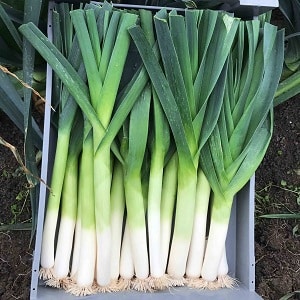
- Columbus – Dutch variety with a pleasant sweetish taste. The plant reaches 70-80 cm in height, stem - 20 cm, diameter - 6 cm, weight - 400 g. Does not require hilling to whiten the stem.
- Vesta - a productive variety, with a stem height of 150 cm, legs - 30 cm, weight - 350 g. Taste - high.
- Elephant's trunk – with a pleasant sweet taste and excellent keeping quality. Leg height 30 cm, subject to frequent hilling.
- Goliath – has wide green or gray-green leaves, the bleached part is about 30 cm, 6 cm in diameter, weighing 200 g.
- Kilima – highly productive early variety. White part - 10-25 cm, diameter - 3-4 cm, weight - 150 g.
Mid-season leek varieties are less productive than early ones, but have better qualities.The ripening period is 150-180 days.
Distinctive features are wide leaves of blue-green color, weight of the stem - 200 g, height - 20-25 cm.
The best mid-season varieties:
- Jolant — the variety is resistant to fungal diseases and is characterized by high yield. The height of the stem is about 30 cm, the bulb is weakly expressed, the leaves have an anthocyanin tint.
- Kazimir - a tall and compact plant with high productivity, resistant to fungi. The leaves extend vertically from the stem, the bulb is weakly expressed, the height of the stem is 25 cm, the diameter is 3.5 cm.
- Kamus - a plant of medium height. The leaves are concave, green in color with a waxy coating. Leg height - 20 cm, diameter - 2.5 cm.
- Tango - frost-resistant, productive variety with vertical leaves. Leg height - 12 cm, diameter - 5 cm, weight - 200 g.
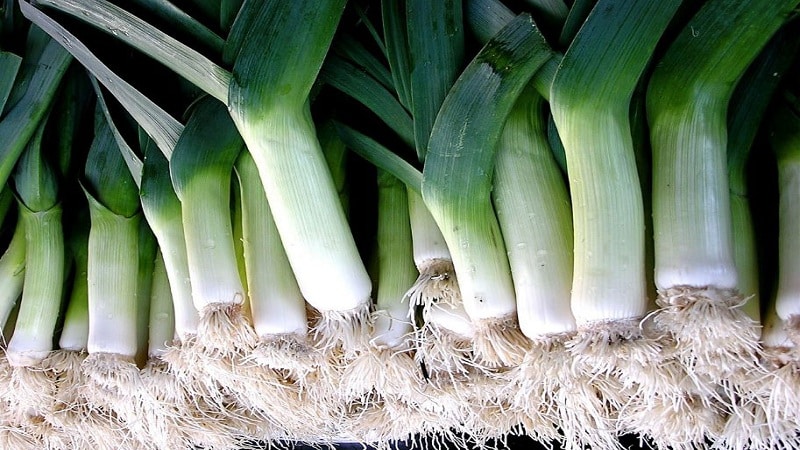
Late varieties ripen for more than 180 days, are characterized by high productivity, and are stored for a long time. The leaves are blue-green in color, with a waxy coating, densely located on the false stem, extending from it at an angle of 90°. The leg is short and thick.
Late varieties of leeks:
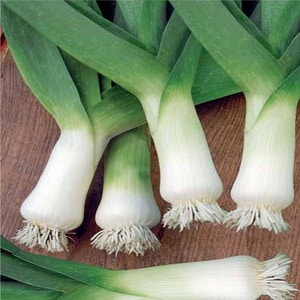
- Karantansky - height of the white part 25 cm, weight 200-300 g. The leaves are spreading, dark green.
- Elephant - Czech variety, resistant to frost and drought. It has an islandy taste. Leg height - 25 cm, weight - 200 g.
- Autumn giant - Dutch variety, has a large white part about 40 cm in height, with a diameter of 7-8 cm. It is stored for a long time in the cellar.
- Asgeos - a frost-resistant variety with wide bluish-green leaves. Leg height - 20 cm, weight - 350 g. Taste - semi-sharp.
Features of growing leeks in open ground
The culture is characterized by a long growing season - 150-200 days.Therefore, it is preferable to grow leeks through seedlings, this rule especially applies to the central and northern regions of Russia. Sowing is carried out in mid-late February. The length of daylight hours for leeks is at least 10 hours, so when sowing early, the seedlings are illuminated with phytolamps.
In the south of the country leek seeds embedded directly into the ground, starting from the second ten days of May.
An important condition for obtaining a rich harvest is maintaining the temperature regime. High temperature even at the seedling stage leads to the formation of a flower arrow in the first year of the growing season, and not in the second.
It is better to plant leek seedlings after potatoes, tomatoes, cucumbers, peas, beans, and cabbage.
Leeks are resistant to cold and can withstand frosts down to -5...-7°C. In regions with mild winters, the plant can be kept under cover of snow in open ground. At the same time, rainy and cool summers lead to the formation of a thin and short stem and loss of taste.
Sowing dates
The timing of leek planting differs depending on the climatic conditions of the individual region and variety. Favorable dates of the lunar calendar are also taken into account.
Early-ripening varieties are sown in April, mid-ripening - in late February-early March, late-ripening - in late January-early February.
In the northern regions of Russia, seedlings are sown in April-May. In central regions with a more favorable climate, sowing work is carried out in the second ten days of February. In the south, leeks are sown directly into the ground in late May-early June.
Sowing dates according to the lunar calendar for 2020:
- January - 1, 5-9, 11, 14-16, 21, 22, 25, 29;
- February - 2-4, 10, 13-15, 17, 18, 20, 21, 24, 28, 29;
- March - 1, 3-5, 10, 11, 14-16, 18, 19, 21, 22, 29-31;
- April - 2-4, 6, 7, 9, 10, 14, 15, 23, 25, 27-29;
- May - 2, 3, 5, 6, 9, 12-14, 20, 22, 23, 25, 27-29;
- June - 1, 2, 4, 8, 11-13, 18, 19, 22, 24, 26-29.
Growing seedlings
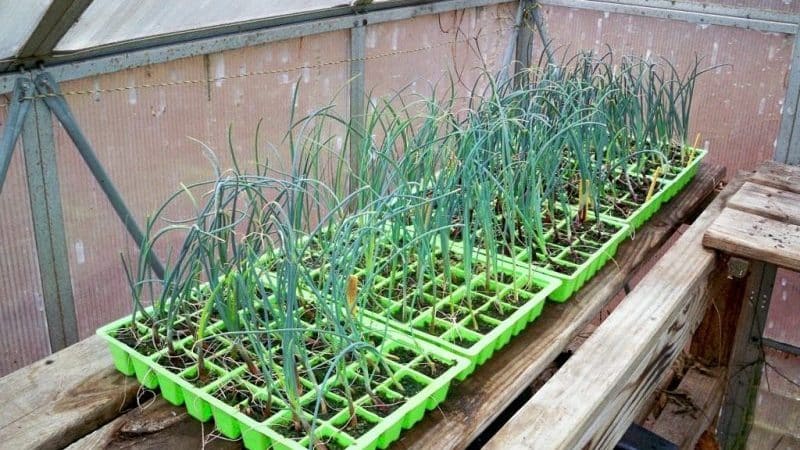
Sowing crops for seedlings is the best way to obtain healthy plants and a large harvest. Seed material is pre-disinfected and soaked to increase germination. Sow in boxes or separate containers. Standard care: watering, picking, fertilizing, hardening in the fresh air.
Seed preparation
Before sowing, the seeds are soaked in warm water for 24 hours, then dried in the open air or filled with water +40°C and left in a closed container for 3-5 hours. Then the planting material is washed with running water and dried.
To disinfect seeds, use a dark solution of potassium permanganate or Fitosporin.
Soil preparation
Loose and nutritious soil is ideal for growing leek seedlings. Heavy, clayey soil is not used. In such an environment, it is difficult for sprouts to break through to the surface.
The seeds are embedded in a ready-made substrate for growing seedlings of cucumbers, peppers, and eggplants, enriched with nutrients. If desired, you can prepare the soil yourself.
To do this, combine 10 liters in a bucket to choose from:
- peat, garden soil, humus (1:1:2);
- ash, ground chicken or quail egg shells, peat, moss, sawdust, turf in equal proportions.
The soil mixture is pre-watered with a solution of potassium permanganate or “Fitosporin”.
To deoxidize, add a glass of wood ash to the soil. Alkaline soil is normalized with dolomite flour.
To increase fertility, potassium salt, compost, urea, and superphosphate are used.
You can use any container for growing seedlings: tetrapacks, plastic trays, boxes, large glasses. The containers are doused with a hot solution of potassium permanganate or boiling water.
An excellent alternative to plastic boxes are peat tablets. They simplify the process of sowing seeds - there is no need to prepare the substrate yourself. The tablets maintain a constant level of humidity, preventing the soil from drying out.
Sowing
The technology for sowing seeds differs depending on the container used:
- 3-4 seeds are placed in separate containers to a depth of 1 cm;
- one seed is sown in common trays to a depth of 1-1.5 cm with an interval of 4-5 cm;
- When sowing into a snail, the seeds are laid out every 5 cm, retreating 2-3 cm from the edge.
The containers are filled with moist substrate and planting material is distributed. A layer of 0.5 cm of sand or peat is poured on top, watered and polyethylene film is stretched. The seedlings are left in a dark place at a temperature of +21...+25°C until sprouts appear.
Sowing into a snail
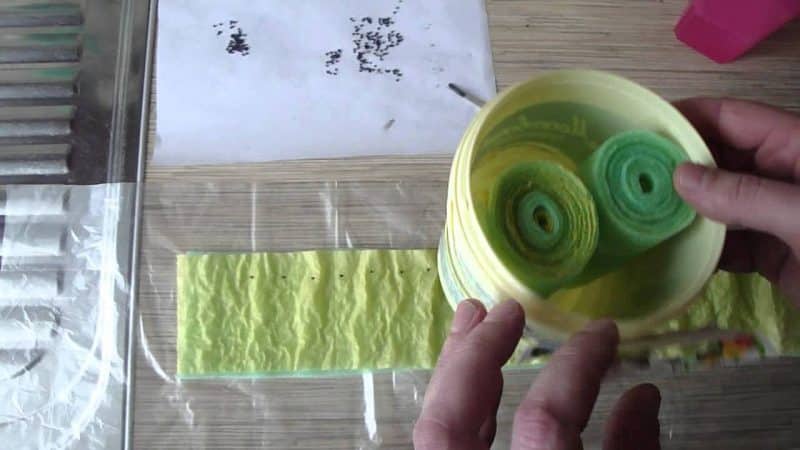
Sowing seeds into a snail is a proven method for producing strong, healthy leek seedlings.
To twist the snail, use:
- lining under the laminate or thick polyethylene film 10 cm wide;
- soil mixture;
- pharmaceutical gum;
- a pallet larger than a roll.
Sowing technology:
- moist soil is poured onto the strip, moving 2 cm from the edge of the strip;
- the seeds are lightly immersed in the soil, maintaining a gap of 5 cm;
- the tape is rolled up and secured with rubber bands;
- the snail is placed in a tray with the seeds facing up;
- the soil is moistened with a sprayer and covered with a plastic bag;
- After germination, the bag is removed and the snails are transferred to a sunny windowsill.
Features of caring for seedlings
Compliance with the watering regime, air temperature and daylight hours, applying fertilizers, picking seedlings from a common container into separate glasses, and hardening in the fresh air allow you to grow strong seedlings and ultimately get a rich harvest.
Watering
Leeks are watered frequently and abundantly - 2-3 times a week. Young stems are too thin and easy to damage. Therefore, watering is carried out carefully through a sieve or with a syringe at the root.
Spraying from a spray bottle moistens the stems and washes away dust from them.
Top dressing
Leek seedlings are fertilized twice:
- 14 days after germination;
- 7 days before transplanting into the garden.
As a top dressing, use Kemiru-universal or dissolve 5 g of potassium chloride, 20 g of superphosphate, 10 g of urea in 5 liters of water.
Chicken or quail droppings are considered the best feeding for leeks. Take 500 g of droppings per 10 liters of water, mix thoroughly and carefully water the seedlings at the root.
Normal daylight hours and temperature conditions
After 2-3 weeks, after the sprouts appear and get stronger, the container is taken out onto a glazed balcony for a week. The optimal air temperature at night is +10...+12°C, during the day - +15...+17°C. Then the air temperature is increased to +13...+15°C at night, +18...+20°C. The leeks are kept in this mode until they are transferred to the garden.
The normal daylight hours are 12 hours. When sowing in late January-early February, the seedlings are illuminated with a phytolamp or LED lamp.
Picking and trimming
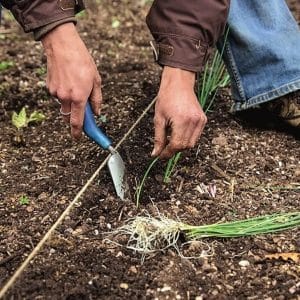
If the seeds were sown in a common container, the seedlings are planted in separate glasses. Strong seedlings are carefully dug up with a teaspoon and planted in prepared containers with moist soil.
To form the correct bulb, soil is added to the container as the seedlings grow.
The stems are trimmed once every two weeks.The height of the seedlings is maintained at 10 cm. This creates favorable conditions for the proper development of the root system and thickening of the stems.
Reference. After a month, the seedlings in a common container are thinned out, leaving a gap of 3-4 cm.
Hardening off seedlings
A week before planting in open ground, the seedlings are taken outside for hardening. The container is placed in partial shade. The time the seedlings spend in the open air is gradually increased, starting from 30 minutes and ending with 16 hours.
Planting in open ground
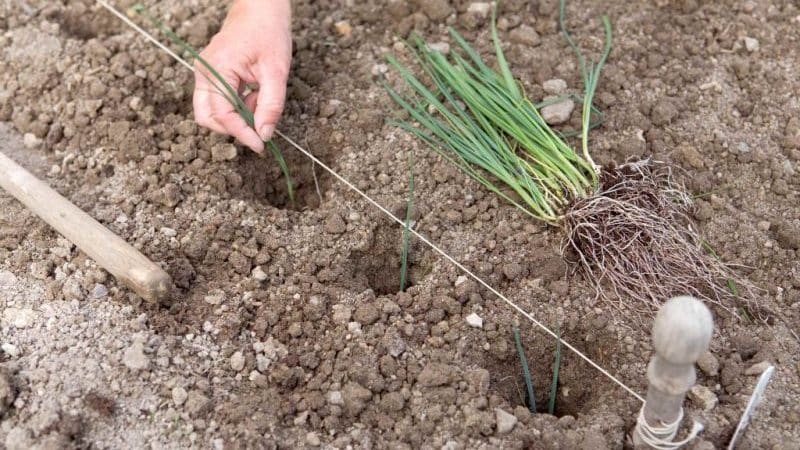
Leek seedlings are transferred to open ground after the appearance of the third leaf, approximately 55-56 days after full germination. Before planting, pinch the roots and leaves by a third. This allows you to grow the white part of the correct shape and speed up rooting.
Site preparation is carried out in the fall or spring: the soil is plowed deeply, fertilized with humus, and the beds are marked.
Leeks grow best in neutral acidic soil. To normalize the pH, add slaked lime or dolomite flour (400–500 g per 1 sq. m).
Reference. It is not advisable to plant leeks in the same place more than once every three years.
When planting, the roots of the plant are dipped in a mixture of clay and mullein (1:1) for better survival.
Seedlings are planted in furrows 10-13 cm deep at a distance of 15-20 cm. The width between rows is 35-45 cm. A nutrient solution is poured into the grooves - 10 liters of humus, 0.5 liters of wood ash.
Further care
Rules for caring for leeks:
- The beds are watered with both warm and cold settled water (10 liters per 1 sq. m) every 4-5 days, increasing the number of waterings during drought. Soil moisture is maintained constantly, preventing drying out and stagnation of water. At the beginning of plant growth, the soil is shed with water to a depth of 7-10 cm.
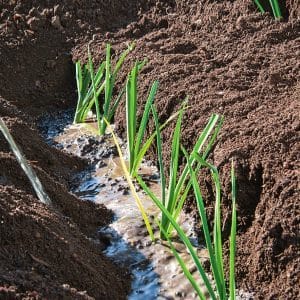
- After rooting, the seedlings are hilled once every two weeks to whiten the stems and improve the taste.
- The soil is loosened after each watering. Weeds are removed as they grow.
- The beds are mulched with sawdust, hay or straw to reduce the amount of loosening and weeding.
- Leeks are fertilized with a solution of chicken manure with phosphorus and potassium: one part of manure, 20 parts of water, 35 parts of superphosphate.
Diseases and pests
Viral mosaic poses a danger to leeks. The disease does not manifest itself when growing seedlings and cannot be treated. The carrier of the virus is the melon aphid.
The first symptoms appear after transferring the seedlings to a permanent place: yellowish longitudinal spots appear on the stems, and the development of the plant is suspended.
Leeks are often affected by fungi that cause rust (bright yellow pads on greens) and downy mildew (dry tips of feathers, white or white-gray color of greens). For treatment, use a solution of copper oxychloride (40 g per 10 l) and Fitosporin (5 g per 10 l).
Prevention of viral diseases:
- weeding;
- insect control;
- crop rotation;
- planting varieties resistant to viruses;
- disinfection of seed material before sowing;
- removal of infected plants from the site.
Leek plantings are most often attacked by the onion fly. The pest has an incredible appetite and is capable of leaving the gardener without a harvest.
Methods of pest control:
- dusting with wood ash (300 g per 1 sq. m), a mixture of wood ash and tobacco dust (1:1), ground red pepper (2 tsp per 1 sq. m);
- spraying plants with tobacco infusion (200 g of shag per 10 liters of hot water, leave for 12 hours, mix in 50 g of laundry soap shavings).
Harvest and storage
Harvesting is carried out before the first frost. The plant tolerates frosts down to -7°C.The leeks are dug with a shovel and left on the beds to dry.
The stems, cleared of soil, are cut in the area of the onion roots and taken for storage in the cellar. Leaves should not be cut, otherwise the plant will quickly wither.
The optimal temperature for storing leeks in the cellar is –1…+1°C, humidity – 80-85%. Wet river sand 5 cm thick is poured into the boxes. The stems are placed vertically on top and sand is poured between them. Shelf life - 6 months. Such boxes can also be placed on a glazed balcony.
To store leeks in the refrigerator, the leaves and roots are trimmed and placed in tight bags with holes, 6-8 pieces each. Storage temperature -5°C for 4-5 months.
Leeks are stored in the freezer in crushed form: a layer of up to 5 cm is laid out in thick bags.
This is interesting:
How to properly cook and eat leek soup for weight loss.
The health benefits and harms of leeks: why they are good and how to use them correctly.
Conclusion
Planting leeks as seedlings allows you to harvest before the onset of persistent frost. When choosing a sowing date, gardeners are guided by the lunar calendar and the climate of the growing region. Sowing work is carried out from the end of January (Siberia) and ends in May in the south of the country. In the central regions, including the Moscow region, seeds are sown in March-April.
The crop loves abundant watering, needs hilling of stems, loosening the soil, weeding, feeding with minerals and organic matter, protection from viruses, fungi and insects. Have a healthy and rich harvest!